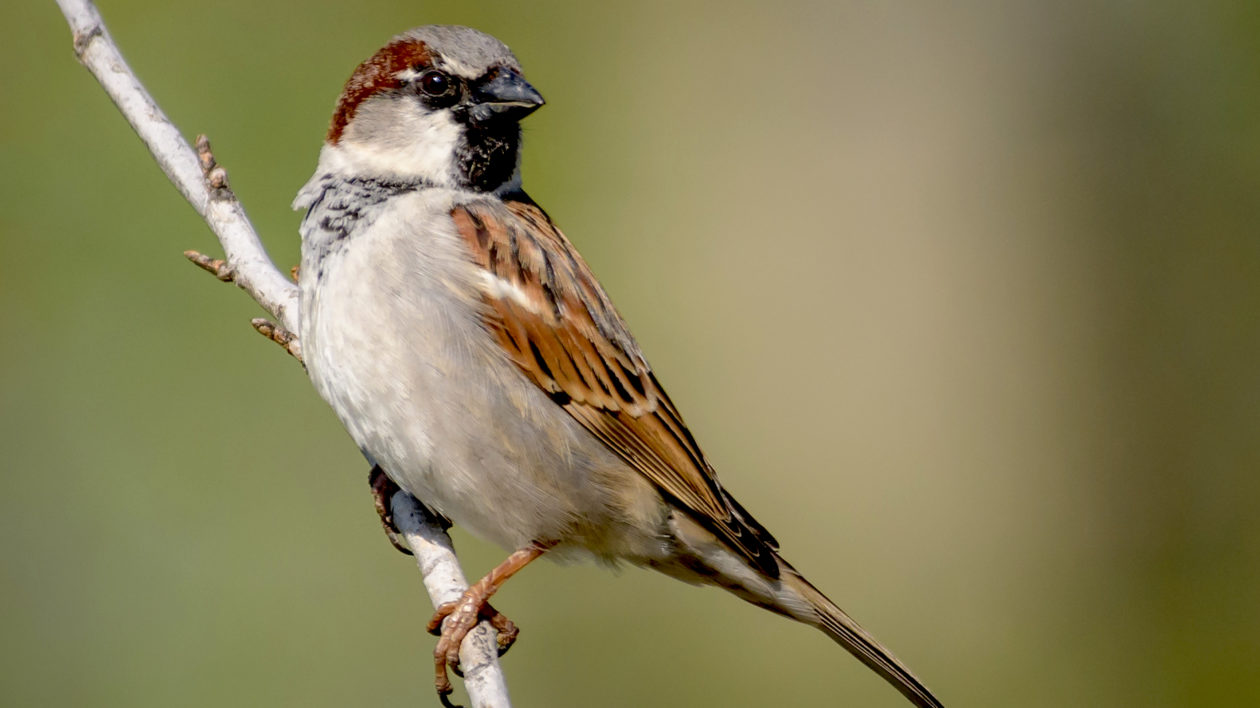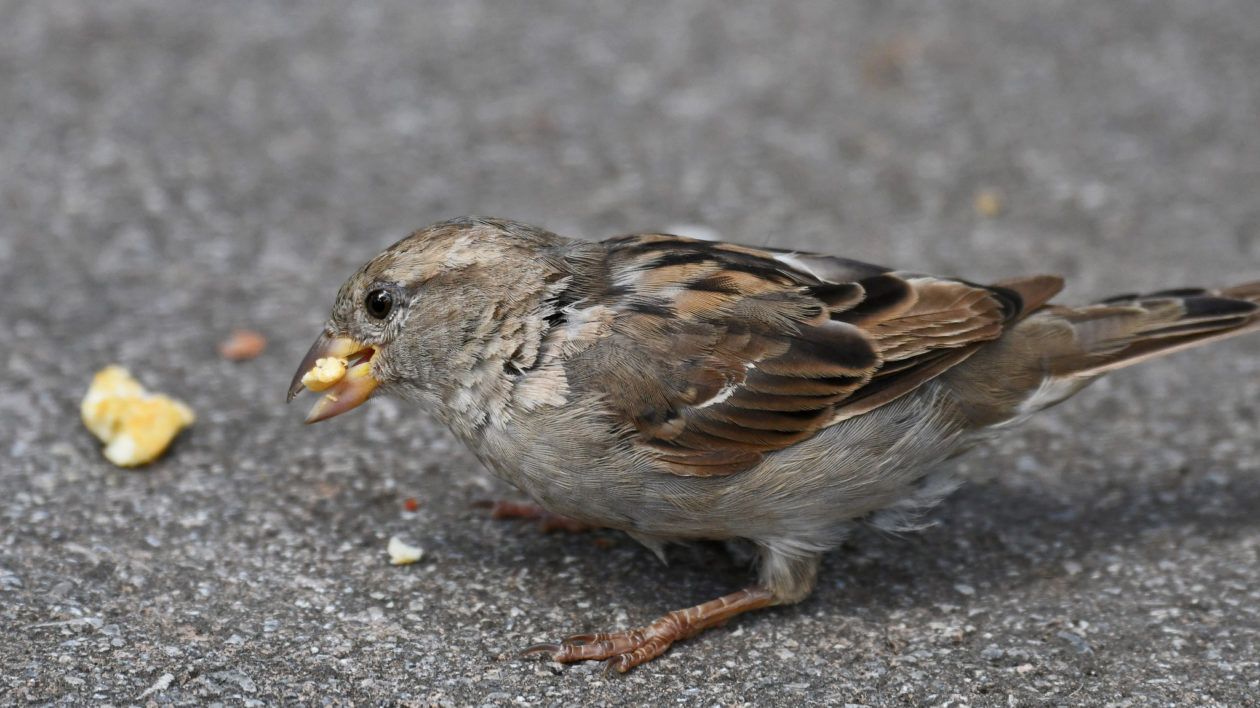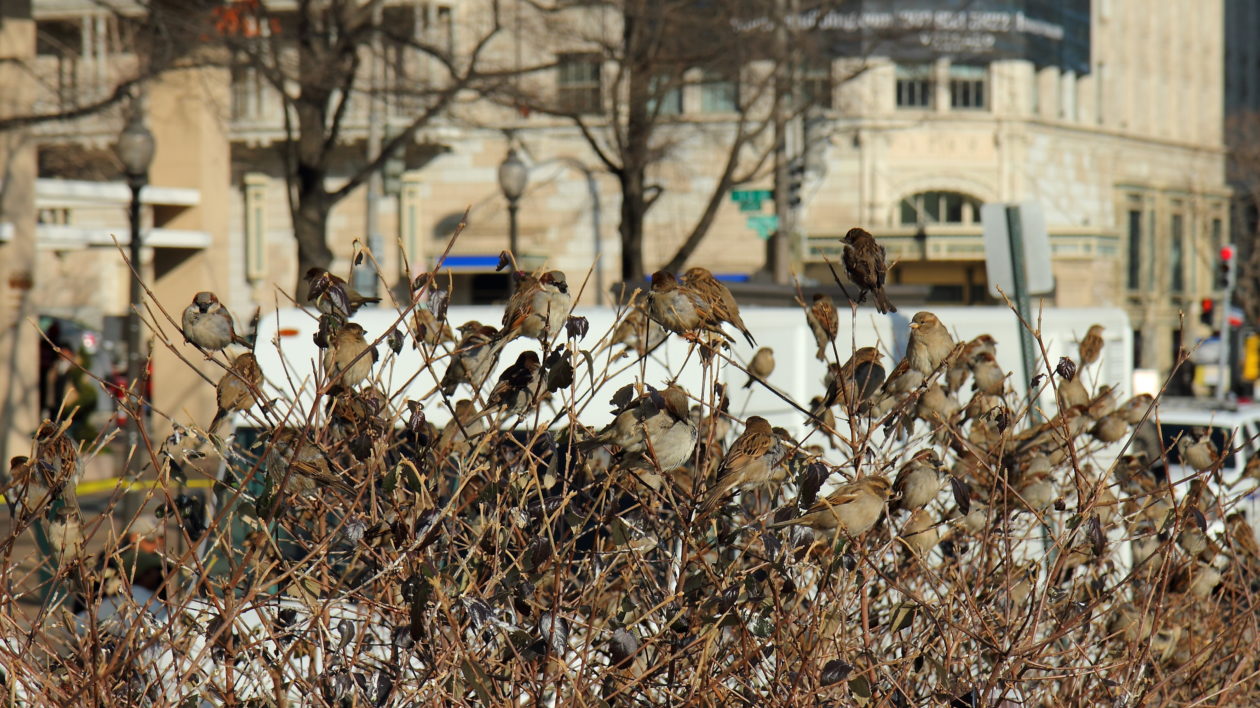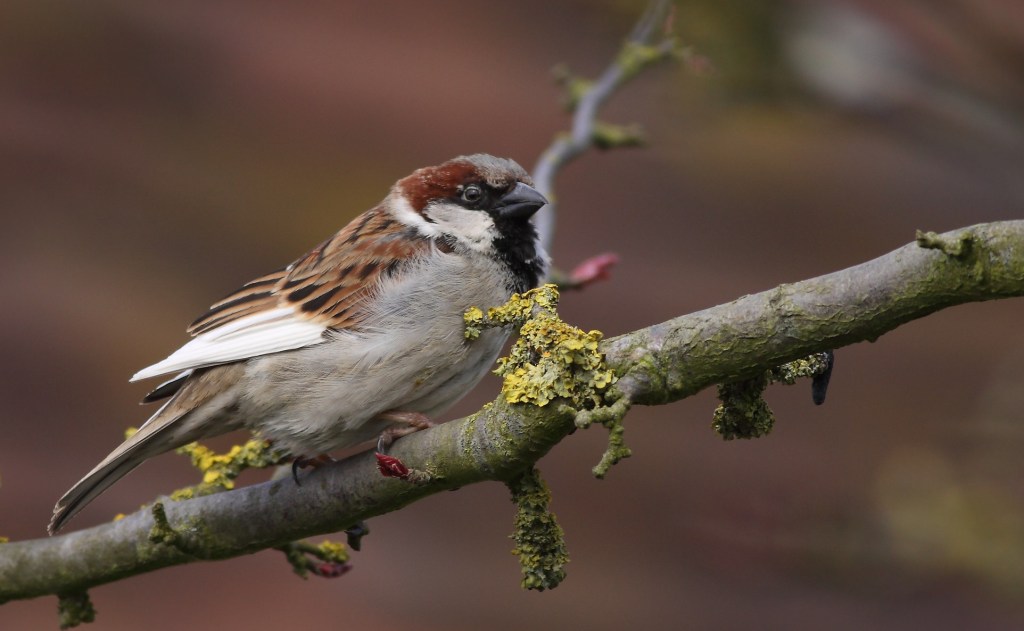I look out my window, and they’re everywhere: hundreds of house sparrows flit around our shrubs, hop around the yard, and steal food from our backyard chickens.
At this time of year, the males puff up and display, making them appear like much larger birds. They cheep incessantly, often drowning out other birdsong.
Given their constant presence, it seems odd to be writing this: House sparrow populations have been declining worldwide, including in their native range.
House sparrows are often considered one of the most adaptable birds, capable of thriving amongst our farms, suburbs and cities. The real story of their spread and decline is a bit more complex, and may have implications for urban conservation.
The Sparrow Fad
The house sparrow (Passer domesticus) is native to Eurasia, but beginning in the mid-1800s, it spread around the globe. Largely due to intentional releases by humans, house sparrows are now found on every continent except Antarctica, as well as many islands. It is the most widespread wild bird on earth.
As with many aspects of conservation history, many of the details of sparrow introductions are poorly documented. The first introduction to North America was to New York City in 1851 or 1852, although the 8 pairs released seemed to fare poorly. However, this set off a wave of introductions throughout the United States.
For a time, some sources refer to a “sparrow fad,” with private individuals breeding birds, and others catching them and releasing them into new areas. Nest boxes were installed in cities to increase sparrow populations. Ornithologists and others raised concerns over the merits of house sparrows, but their arguments proved futile against sparrow enthusiasts releasing cages full of birds.
The reason for many of these reasons was for pest control. For instance, their 1868 introduction to Philadelphia was apparently an effort to control inchworms. As with so many such pest control efforts, the cure proved worse than the disease. They thrive on a variety of foods, including spilled grain and even garbage.
The house sparrow is also an aggressive little bird. It nests in cavities, and pushed out native species like Eastern bluebirds. Backyard birders who erect birdhouses have undoubtedly noticed house sparrows bullying wrens and other native species.
Public sentiment turned quickly against the house sparrow. By the 1880s, just three decades after the first introduction, several U.S. cities paid bounties for the birds. But by then the bird was firmly established – and spreading.

Recent research published in the Proceedings of the Royal Society B found that house sparrows underwent genetic changes, including modified skull development and a gene that helps create the enzyme amylase that helps break down starch. The researchers hypothesized that these changes helped sparrows adapt to human settlements dominated by agricultural fields and livestock. The sparrows, according to the research, diverged from other Old World sparrows around 11,000 years ago, just as agriculture was taking hold in the Middle East.
The house sparrow appears to be a clear winner in the Anthropocene: an adaptable bird capable of thriving equally well on cities and in farms.
But over the past few decades, ornithologists have noted a new trend: house sparrows are in widespread decline. According to the Cornell Lab of Ornithology, house sparrow numbers in North America have declined by 84 percent since 1966. In Philadelphia, the city where the sparrows were introduced to control inchworms, the birds have largely disappeared.
Many birders view this as a good-news story. After all, house sparrows compete with native species and are generally viewed as a pest. However, the bird is experiencing similar declines in many parts of its native habitat, including the United Kingdom and Western Europe.
In England, house sparrow populations have declined by half. The species is listed by the Royal Society for the Protection of Birds as a species of high conservation concern. While the United Kingdom population has recently stabilized, the bird remains of concern to conservationists. European countries now recognize a World Sparrow Day to raise awareness of the plight of this once-abundant species.
What happened?

Sparrow Falling
Theories abound as to why house sparrows have declined. The answer likely lies in a combination of factors, all tied to rapid changes in both cities and farms. House sparrows may be highly adaptable, but that doesn’t mean they can thrive with every modification humans make to the environment.
The first house sparrow decline was actually reported in the 1920s, when automobiles began widely replacing horses. Sparrows feasted on the huge amount of spilled grain found in cities. When that food source was removed, sparrow populations decreased.
The Royal Society for the Protection of Birds and others note that changing agricultural practices likely play a significant role in the current sparrow decline. Once, farms were diverse, with crop fields and livestock barns scattered across the landscape. New, clean, intensified monocultures result in less spilled grain, and less cover around fields. In many parts of the world, other birds associated with farmland are also in decline.
Livestock is more frequently raised in confined operations, sometimes even indoors. All this results in fewer opportunities to feed on grain.
Similarly, city sanitary practices have improved, which may make finding meals more difficult for sparrows.
Research published in the journal Frontiers in Ecology and Evolution found that a combination of poor diet and air pollution induced physical stress on house sparrows, leading to reduced reproductive success.
The widely reported global insect decline may also be a significant factor. Many think of house sparrows as vegetarians, gobbling bird seed and grains. But, as with many birds, they rely on protein-rich insects to feed their young.

Implications for Urban Conservation
There are still 540 million house sparrows flying around the planet, so this bird is not in danger of going extinct. It’s still abundant in many places – including my neighborhood, where a mix of native vegetation, bird feeders and backyard chicken coops provide the diversity of habitat and food sources that enables these birds to thrive.
So why is the house sparrow decline important?
In part, it shows how little we understand urban ecology. Even conservationists often assume that common, adaptable species will be able to adapt to any change. That’s clearly not the case.
All ecosystems change, but human environments often change rapidly. If we’re thinking about protecting biodiversity in cities – and in a world that will have 9 billion people, we have to – we have to think about how changes impact wildlife. Just as modification to a tropical forest affects wildlife, so too do changes in farming practices, changes in city design, even changes in bird feeding habits.
I wouldn’t miss the house sparrow from my neighborhood. It’s an invasive species that competes with native birds. But globally, the sparrow’s decline is a story we should heed, as it may help us better understand how to coexist with nature in the Anthropocene.




I live in South buffalo, New York. I’m wondering where all the sparrows have gone. They seemed to have disappeared about a month ago. There were so many around now they are gone. What had caused this
I’ve had the house sparrow in 4 birdhouses for the past 10 years, but this year I have not seen any making there happy home, why?
I would be very happy to be rid of this nasty bird. It has terrorized our bluebirds and our purple martins and have actually killed them in their nests. They are not native birds to our country and are not protected. We make every effort to eradicate them from our property.
Where have all the sparrows gone.
I live in the eastern suburbs of Melbourne Australia and have noticed the decline of the sparrow over the last 20 years.
I think there are a number if factors,the India Minor is a problem for most species of similar and smaller size because they work as a team to out compete.
The cutting down of trees to make way for medium density housing have reduced nesting sites and seeding grasses, also the efficiency of garbage collection has seen an end to overflowing bins left uncollected for days.
Australian birds like the the aggressive noisy minor have moved into urban settings due to drought conditions elsewhere.
I have also noticed a decline in arachnids. All these things by themselves may not effect the sparrow but as a collection may be too much.
Hi,
I’m in Watertown MA and for the last 14 years we have been supporting a ton of sparrows and other singing birds. We use to go through about 7 pounds of bird seed a day. I noticed that about a month ago, the birds have suddenly stopped coming to our feeder and we don’t hear any birds in the morning like we normally do. Any idea what could have caused their disappearance? Is there an abundance of summer food somewhere else that they don’t need to come to the feeder or could something have caused them to abandon our feeder or displaced their nesting area? We have never experienced this before as our yard and neighborhood has always had an abundance of birds. Now it is quiet and no birds seem to be around.
Bill
I live in a residential area of Brooklyn, NY with many trees. I have been leaving Bird Feeders out in my backyard with various seeds and one with Black Seed only, for about 40 years. We had a huge Oak and a very large Maple tree in my neighbors yard. I always had Cardinals, House Finches, Blue Jays and House Sparrows at the feeders with an occasional Hawk in the Oak tree (Red-Tailed and Coopers) and of course the ever present New York Pigeon (Rock Dove) which loved my garage roof. . During the year a pair of Downy Woodpeckers would grace us with their presence in the old Maple tree and at a Suet Feeder we left out for them. They all added a certain beauty to my Back Yard when I looked out the window. In the Spring and early Summer we were blessed with Mockingbird’s high up in the Oak and their beautiful song. A few years ago my neighbor decided to cut down the Oak which was about 75 to 100 years old and very healthy and strong. She also cut down the Maple tree. Shortly after that all the birds with the exception of the House Sparrows and a few House Finches disappeared. The Mockingbirds still come back each year, but not as many as before. My point is that without trees in Urban residential areas, House Sparrows and of course pigeons would be the only birds we would ever see closeup. I personally am happy to look out my window now and see and hear the little House Sparrow at the feeders. Simply Planting more trees and replacing those that are cut down is one of the best ways to maintain the bird populations and the variety of birds; and to help with Global Warming.
This morning we dropped by our other walnut orchards about ten miles away from where we live on our other walnut orchard property, we wanted to check and see if there were birds out there near Valley Home, near Oakdale, California. We did not hear or see not one, WHERE HAVE ALL OUR BIRDS GONE ! All I ever see is Hawks, that I keep an eye on because of my Yorkie and small Poodle. We do have a few doves, only because our neighbor raises them. I really miss all of our song birds, living in the country most of my life I am used to hearing them. There is No sounds of birds.
Gone , I noticed within the last ten years, the families of Sparrows have disappeared from my bushes and trees all around our house, we have walnut orchards and there are not a one around . I would go out on our porch and they would follow me around. THEY ARE FLAT GONE ! I Haven’t seen one in years, it’s so sad. In fact I hardly see any birds! We have a small fruit orchard with every kind of fruit tree , yet no birds eating the fruit like in the past. We don’t use pesticides. There was a time when the fruit got ripe and we would get up one morning and there would be No fruit, because the birds got to it first. We miss them, we do not hear or see the Mockingbird or Meadow Larks, the Robins or those mean Blue Jays. Something is in the air that is killing them off or something they are eating. They used to take Canaries into mine to detect if the air was bad, remember what happened to them. That should tell us all something!
We haven’t had any type of flocking birds in the last two summers here in Sacramento, CA. But, it is all over the state; no flocks of birds. No finches, sparrows, etc. All we have are pigeons and a few hummers. We drove by the almond and walnut orchards without seeing one bird flying around, let alone a flock. Used to see lots of egrets, but most are gone too from the rice fields. You might see one or two where flocks used to be. Nothing is being said in the news…what happened to them?
Today sparrows tomorrow human what is your opinion I want the topic
Sparrows today humans tomorrow
I assume you are familiar with the Tadeus Zagajweski tale of the aging philosopher who was asked: “ what in life has mystified you?”
The reply: “the ubiquity of sparrows”.
Ken Ytuarte, Catskill, NY
I REALLY ENJOY WATCHING THOSE IBGB RASCALS ….
( ITTY BITTY GREY BIRDS ) ….
One reason they may be declining in my area is because I shoot them with a pellet gun,they’re totally invasive when it comes to other species their beak is harder than the beaks of most other species so they always win the fight, they get in the nesting boxes and nest of other species and Destroy eggs.
As far as I’m concerned they can blow away like Dust in the Wind.
I call them the Cockroaches of the bird species.
I am a little surprised to see no mention of the reduction of available nesting sites for house sparrows since the modernisation of housing. I think that the closing out of orifices in modern buildings and modernised may well restrict the success of the house sparrow today? In my Hampshire UK neighbourhood house sparrows are virtually non-existent in modern housing estates, surviving it seems in areas featuring mostly old buildings with many nooks and crannies providing safe nesting sites. This may appear to be a simple conclusion but maybe a very important part of the jigsaw?